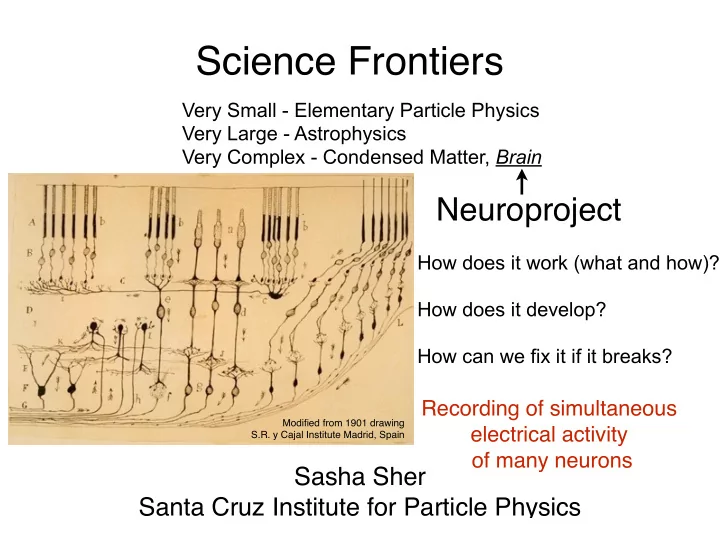

Science Frontiers Very Small - Elementary Particle Physics Very Large - Astrophysics Very Complex - Condensed Matter, Brain Neuroproject How does it work (what and how)? How does it develop? How can we fix it if it breaks? Recording of simultaneous Modified from 1901 drawing electrical activity S.R. y Cajal Institute Madrid, Spain of many neurons Sasha Sher Santa Cruz Institute for Particle Physics
Technology UCSC AGH UST, Krakow, Poland 1 mm 512 electrodes with 60 and 30 micron Salk Institute spacing U. of Strathclyde, Scotland
Select technology results so far • Developed 512 electrode system for recording activity of 100s of neurons in-vitro . • Developed 512 electrode system for recording and stimulating activity of 100s of neurons in-vitro . • Developed 64-electrode wireless readout system for recording neural activity in awake behaving rats. • Developed 512 “bed of nails” electrode array for recording activity inside neural tissue. • Published results in IEEE proceedings, Journal of Neural Engineering, Nature Neuroscience, etc.
Select scientific results so far • Discovered and described new retinal pathways responsible for motion and color processing • Described how retina encodes information at a neural population level • Measured retinal functional properties at the resolution of individual photoreceptors • Results published in Nature, Nature Neuroscience, Neuron, Journal of Neuroscience, Cell, Journal of Neuroscience, Entropy, PLoS One, etc.
Some of the current scientific work saline solution retina electrode • Investigation of retinal function and development in array 1 cm lens mice (collaboration with David Feldheim, UCSC Biology) computer display co • Adult retinal plasticity following laser photocoagulation • Photovoltaic retinal prosthesis
UCSC MCD Biology • Faculty: Alan Litke, Sasha Sher Applied Physics • Two postdocs Ophthalmology • Four UCSC graduate students (Physics, Biology, Electrical Engineering, Environmental Toxicology) Institute of Photonics • Four Undergraduates (Physics, Applied Math, Biology) • Two High School students AGH USTK. Poland • SCIPP technical stuff: Sergei Kachiguine, Forest Martinez-McKinney. Funding: National Science Foundation, Burroughs Wellcome Fund, Pew Charitable Trusts, National Eye Institute / National Institutes of Health, UCSC.
Recommend
More recommend